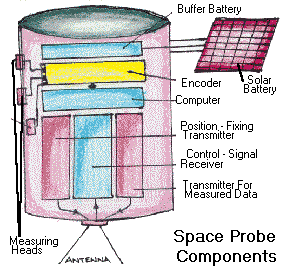Major Components of a Satellite
Katrina G. / Physics 336 / 17 April 1997

Satellites are complex machines which have intricate components and
may be expensive. A satellite is any unmanned spacecraft projected from
Earth with sufficient speed to coast out of reach of Earth's gravity to
attain "escape velocity". Builders of satellites try to create
an efficient satellite by making the parts more efficient and less expensive.
Every part of a satellite plays an important role in launching it.
Components
of a Satellite
There are many components in a satellite, such as the subsystems. Subsystems
are groups of devices that help the instruments work together. There are
many different kinds of subsystems, each with its own purpose. For example,
command and data handling subsystems consist of computers that gather and
process data from the instruments and execute commands from Earth. A power
subsystem generates, stores, and distributes a satellite's electric power.
This can include panels of solar cells that gather energy from the sun.
Some things that help satellites work are a power supply and distribution
system, telemetry, communications, and navigation system, on-board intelligence,
and thermal management equipment. There are also different kinds of satellites
which require different components to launch it. Some components needed
in a multispectoral satellite are a scanner rotator, spherical focal point,
focusing mirror, radiation gathering mirror, and a beam of radiation.
Engines
in a Satellite
The engine is one of the most important parts of a satellite. A new
"aerospike" engine was made with nozzles which have limited adaptability
to pressure but work good in a vacuum. In some cases, payloads are needed.
A payload can be a weapons system, optics, communications system,or scientific
instruments. The payload cannot function without a satellite that supports
it.
Cost of a Satellite
A lot of money is needed to make and launch a satellite. The price
to launch a satellite sometimes depends on its size. A satellite being
launched by TRW is a 20 foot tall model of the Earth Observing System satellite,
complete with wing-like solar panel and cameras. Another is the half-size
67 foot prototype of Venture Star called X-33 which is supposed to be launched
in 1999. However, no matter the size, satellites are expensive. Lockheed
Satellite Company recently gave $1 billion for development of a satellite
to the winner of a satellite design contest. However, without government
grants, Lockheed Martin might not be willing to pay the $4 to $8 billion
needed to launch the Venture Star. A new innovation by Lockheed Martin
and NASA will shrink the shuttle's price-per-payload from $10,000 to $1,000,
cut repairs and inspection costs, and reduce the time needed to build it.
It is hard to launch an expensive satellite when hardly any contributions
are made. Congress and the media seem not to be interested in space science
and satellites, thus reducing public support for spending on space and
satellites. Cassini comments on the subject, "I'm probably working on
the last big spender among satellites--Cassini. That's more than $1 billion
of development costs."
Reducing the
Cost
There are new innovations that may reduce the cost of a satellite.
The price has gone up. Goldin, a reporter, says, "Many people have
aspirations of going into space; they should be able to afford to live
those out". There are ways to reduce the cost, though. Small satellites
and less expensive launch vehicles may reduce the cost of putting one into
space. Designers of satellites push constantly to make them light and inexpensive.
Gravity's
Role In Flying A Satellite
Certain conditions are needed in order for gravity to fly a satellite.
For a satellite to orbit Earth, it has to be balanced inwards by gravity
and outwards by centrifugal force. If a probe accelerated until its speed
matched the planet it's orbiting, gravity can do the rest. Therefore, if
a probe's speed is deliberately increased beyond seven miles/second, it
will fly along an elliptical (egg shaped) path that can be directed out
or inward from the Earth's orbit. However, the gravitational pull of a
planet is very local and small so a space probe that passed close to it
would not automatically be pulled into orbit. Satellites can also be used
to measure the sun's damage. "The same space technology we've used
to probe the other planets, to survey the moon and measure the sun's influences,
can reveal the difficult process that shapes our environment.", says
Tim Honnermann,Vice-President of TRW.
Instrument Design
Each instrument in a satellite needs to be tested thoroughly. Satellites'
instruments are designed, built, and tested individually. Workers install
parts on satellites one at a time. It is then tested under conditions that
it will encounter in space. Satellites have to be tested especially before
they are launched. Many satellites require minor adjustments of their orbit
before they begin to perform and function. Once it is placed into stable
orbit, it can remain for a long time without adjustment. Most satellites
are launched by rockets that fall into the ocean after the fuel is spent.
Conclusion
Satellites have many complex components which have important functions.
Through studying these components, we can better understand how satellites
are launched. Also, satellites are very expensive. Many people are held
back from satellite design and manufacture because they cannot afford it.
References
Encyclopedia Britannica. "Science and Technology Illustrated".
Chicago, l994.
Guinn, Robert P. The New Encyclopedia Britannica Vol. l0. Chicago,
l994.
Hagan, Brian J. "Voyagers Go Lite". Design News. 6 Sept.
l996: p 81, 88.
Knight-Riddler/Tribune Information Services. Press-Telegram. Long Beach,
CA., 1996.
MacLean, Hunter. Satellite Communications Services Industry. "A
Satellite Out of
Tune". Infotrack Magazine Index Plus. 8 April l996.